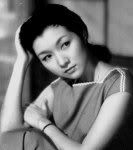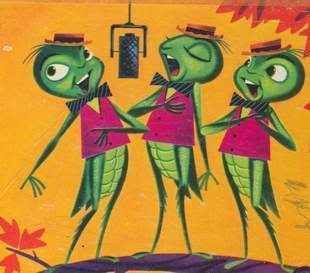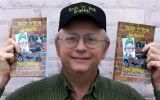My Dad brought me a box of old records the other day. I see vintage recordings often, but this collection was different; it was a group of LPs and 45s from our house when I was growing up in the 1950s and 60s.
He pointed out a couple of 78s, too. Many people know 78s as the thick fragile discs played on Victrolas in the World War II era and the decades before.
Dad (you might know him as Don Seymour) told me he bought the recordings in Japan while on leave when he was serving near Seoul during the Korean War in 1950-51. Since I've got a turntable which can play at 78 rpm speed, I thought it would be interesting to give the old platters a spin.
The first disc, on the Victor label, contained the titles "Ginza Kankan Musume" and "Waga Yume, Waga Uta." My Dad recalled soldiers in his outfit singing the first song, which translates to "Ginza Cancan Girl." The song was a pop hit in 1949 and was included in a Japanese film of the period starring Hideko Takamine, who apparently performed the theme song, as well. Pressed on the Columbia label, the second disc included "China Night," which he said reminded him of a soundtrack to a movie depicting a Chinese scene; and a song translated into English as "Hill of Pure Heart."
Manufactured in Yokohama and Kawasaki, the discs credit the artists only in Japanese characters, making further identification difficult.
Dad chuckled upon recognizing songs he hadn't heard in half a century or more. Another record in the box, meanwhile, elicited outright laughter from my brothers and sisters.
You may recall David Seville and The Chipmunks who captured number one on the Billboard top singles chart in 1958 with both "Witch Doctor" and "The Chipmunk Song." Born Ross Bagdaserian, Seville created and provided the voices of cartoon characters Alvin, Simon and Theodore, beloved by generations of children.
My siblings were shocked when I revealed to them the long-play record they remembered was actually by another group, The Grasshoppers. "You're kidding!" remarked my sister Karen Germain. Yes, it seems The Chipmunks were so phenomenally popular, eventually spawning a animated television series and 22 hits, that imitators appeared.
The Grasshoppers-- Dennis, Archie and Rickey-- were even so bold as to record their own version of "The Chipmunk Song," adding to the the cartoon character confusion among the young people of America. In fact, The Grasshoppers probably equalled or surpassed The Chipmunks in sales as their album, aimed at the budget conscious customer, was issued in dozens of versions over the years.
The edition in the Seymour family collection appeared on the Parade label and allowed kids to sing along with those musical bugs on such songs as "Big Rock Candy Mountain," "On Top of Old Smokey," and "Glow Worm." The novelty group added to the disarray, intentionally or not, by also including a cover of "Alvin's Harmonica," by the rival Chipmunks.
The Grasshoppers never had enough cache to get a TV series, but they were sharp dressers, especially for insects, wearing straw hats, red vests and green and black striped bow-ties on the record cover.
As The Chipmunks enjoyed their final hit with "Rudolph the Red Nosed Reindeer" in late 1962, the Seymour family's music interest switched to a piano player born in Denmark named Bent Fabricius-Bjerre. Actually this musician smartly dropped the last section in his name and became simply Bent Fabric. His signature composition was called "Alley Cat," for which he received a Grammy award in 1963 for best rock 'n' roll recording. In Danish, "Alley Cat," appearing on the Atco label, was known as "Around the Piano," a title record executives didn't think would entice the American record buying public.
Some folks moved nimbly to a dance invented just for the song and played it at weddings and dance parties. As children, we heard "Alley Cat," dozens of times as our parents learned to square dance while that catchy instrumental played on the hi-fi in the basement.
Mom and Dad belonged to a local square dance group, and danced to waltzes, polkas and western swing numbers by the likes of The Four Notes, Al Russ, and The Southernaires. Those 45s even came with lyric sheets so the tune could be "called" for the dancers.
The box of old records also contained an album of big band tunes with titles many older people recall fondly such as "Song of India," by Tommy Dorsey; "Sing, Sing, Sing" by Benny Goodman; and "I Can't Get Started," by Bunny Berigan. The two disc set also includes the original versions of "Begin the Beguine," by Artie Shaw; "In the Mood," by Glenn Miller;" and "Take the 'A' Train," by Duke Ellington. Also represented in the family collection were numerous LPs by Ray Conniff, which I remember buying at a local dime store to give to my parents as Christmas gifts. During the 1960s, Conniff produced an average three albums (two instrumental and one vocal) every year. He even mined gold in 1966 with a Top Ten take on "Somewhere My Love," also known as "Laura's Theme," from the classic movie Dr. Zhivago.
So, there you have it, a few family stories as told by a box of old records.


 I've enjoyed rock music and writing since I was a teenager in the 60s. I feel lucky to have been around when rock's greatest stars created their most enduring hits. At the same time I found I enjoyed writing, as well. I worked on my high school newspaper and magazine, was editor of several college publications and earned a bachelor's degree from Central Michigan University in 1973. I worked for the daily newspaper in my hometown after graduating, becoming managing editor after a few years. By the 1980s, I moved into public relations. In 1985, my wife Sue and I opened a retail music store, The Record Rack, which we still own. Rock 'n' roll has been integral to me and for the last 2O years I've been earning my living from it even though I don't have a musical bone in my body. In recent years, I've also I edited a small local magazine and launched a micro FM radio station. Now, I'm finally combining my love of writing and rock 'n' roll. I can't sing a note, but I know what I like. I'll tell you all about it when you read on. I hope you have as much enjoyment reading these installments as I've had writing them.
I've enjoyed rock music and writing since I was a teenager in the 60s. I feel lucky to have been around when rock's greatest stars created their most enduring hits. At the same time I found I enjoyed writing, as well. I worked on my high school newspaper and magazine, was editor of several college publications and earned a bachelor's degree from Central Michigan University in 1973. I worked for the daily newspaper in my hometown after graduating, becoming managing editor after a few years. By the 1980s, I moved into public relations. In 1985, my wife Sue and I opened a retail music store, The Record Rack, which we still own. Rock 'n' roll has been integral to me and for the last 2O years I've been earning my living from it even though I don't have a musical bone in my body. In recent years, I've also I edited a small local magazine and launched a micro FM radio station. Now, I'm finally combining my love of writing and rock 'n' roll. I can't sing a note, but I know what I like. I'll tell you all about it when you read on. I hope you have as much enjoyment reading these installments as I've had writing them.


2 comments:
I’ve always enjoyed the Chipmunks, and I’ve heard of the Grasshoppers. And I've gone back in time also to boxes of memories that my parents may have also....bringing me back to the 40's with the Andrew Sisters and the Mills brothers.
And I’m always interested in what story a box has to tell. Thanks for sharing with us, by bringing the words to life. ~Bud~
I found the Hill of Pure Heart/China Night record with a collection of similar records at a flea market recently. Best find ever! They play beautifully, scratchy but otherwise perfect.
Post a Comment